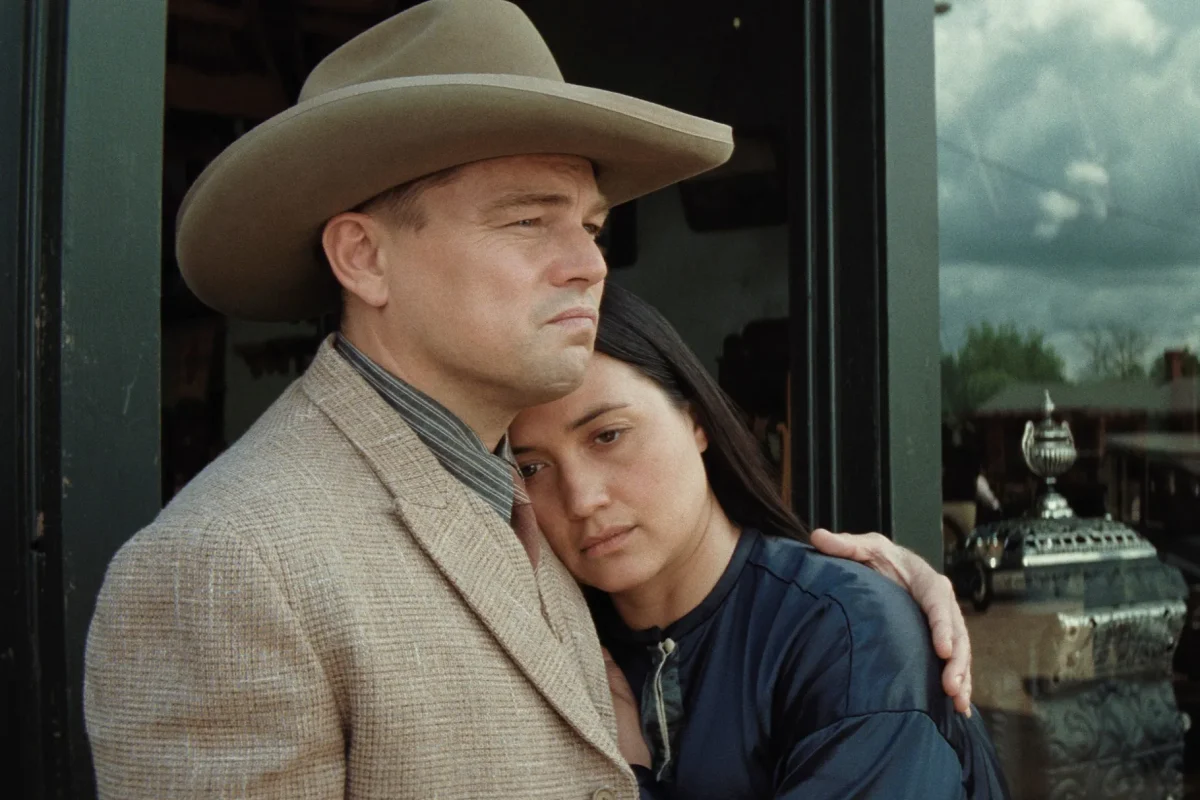“In May, when coyotes howl beneath an unnervingly large moon, taller plants, such as spiderworts and black-eyed Susans, begin to creep over the tinier blooms, stealing their light and water. The necks of the smaller flowers break and their petals flutter away, and before long they are buried underground. This is why the Osage Indians refer to May as the time of the flower-killing moon.”
In a true story that weaves together the blood and deceit tied to the discovery of unimaginable wealth beneath land of the Osage Nation, “Killers of the Flower Moon,” directed by Martin Scorsese and based on the book by David Gran, tells the grim tale of how white greed and betrayal slowly poisons a Native American community.
The film received 10 Oscar nominations: Best Picture, Best Actress in Leading Role for Lily Gladstone, Best Actor in Supporting Role for Robert De Niro, Best Directing, Best Cinematography, Best Costume Design, Best Film Editing, Best Production Design, Best Music (Original Score) and Best Music (Original Song).
Scorsese tells the story through the tensions of the relationship between an Osage woman Mollie Kyle (Lily Gladstone) and her white husband Ernest Burkhart (Leonardo DiCaprio). Together, DiCaprio and Gladstone execute a dynamic that simultaneously showcases hopeless admiration for each other and blind delusion.
Following the discovery of large reserves of oil under land thought to be once worthless, the Osage became some of the richest in the nation. They protected their wealth with the headright system — only those part of Osage families could inherit the wealth. The film begins with Ernest returning from World War I to his uncle, who’s seen as a great benefactor towards the Osage community. From the outset, Ernest is easily influenced by his uncle and enamored by the prospect of wealth that he could acquire from marrying an Osage. He begins chauffeuring for Mollie, and the two quickly fall in love. As Ernest takes on greater roles in perpetrating atrocities against the Osage community, from robbery to hiring hitmen, he also takes part in killing Mollie’s family one-by-one and poisoning her insulin to silence her pleas for help.
DiCaprio’s phenomenal acting captures Ernest’s almost stupid eagerness as he becomes entangled in the web of conspiracy to acquire the rights to Osage oil spearheaded by William Hale (Robert De Niro). The juxtaposition in his character, with one scene depicting him robbing wealthy Osage by night and the next showing a domestic moment between him and Mollie’s children, attests to the twisted mental gymnastics dooming their relationship from the start.
Despite acting alongside De Niro and DiCaprio’s towering legacies and receiving less screen time, Gladstone’s rendition of Mollie was what made the film truly exceptional. Her portrayal of Mollie’s fatigue, reserve and constant silence speaks volumes throughout the dizzying upheaval. Gladstone captures Mollie’s unflinching resolve perfectly, showcasing her internal struggles and her fierce dedication to her people, particularly at the climax of the movie when she pleads her case in Washington D.C.
Although the run time was just under three-and-a-half hours, every moment proves to be engaging: the entire film felt appropriately paced in a way that respects the history and avoids over-dramatizing. Scorsese utilizes the longer length to effectively pay tribute to each victim highlighted in Gran’s book, namely Mollie’s immediate family. Seeing the reactions of Mollie and the other community members allows the full impact of the horror to settle in with each death, slowly building up the tension to the finale with federal investigation.
Another merit of the film is the artistic cinematography. Hauntingly beautiful while simultaneously apocalyptic, Scorsese aptly combines the rustic feel of the American West with the soft colors of nature revered by the Osage. Fiery silhouettes flickering beneath an orange, flame-filled sky. The sickly, muted colors of Mollie wasting away in her bed. The lush, vibrant green of Pawhuska hills sprinkled with white flowers. The style is unexpected and innovative, reflecting a bold artistic choice that almost feels as if both styles — Western and Indigenous — are clashing throughout the film, effectively encapsulating the essential struggle between two worlds.
The film references the Tulsa Massacre after the bombing of Mollie’s sister’s house, underscoring a larger social commentary, forcing Americans to confront the reality of the greed, exploitation and sociopathy inextricably tied to America’s past, and the legacy of blood and tears left in marginalized communities. The ending of the film unfolds with startling rapidity following the arrival of the federal investigators, a cautionary note highlighting the evident precariousness of an illicit empire built upon exploitation and greed.
In the final clip, a radio cameo that narrates the remainder of Mollie’s life up until her death, is delivered by none other than Scorsese himself, making for a resounding resolution. Scorsese’s decision to portray himself from the position of a person capitalizing off of her story in the film mirrors the criticism of his intentions in real life. By acknowledging the potential argument that he too is a benefactor of the cruel history of abuse committed against the Osage community, Scorsese also recognizes his inability to capture the story perfectly without any bias and separate himself from a position of white power.
More than a mere historical retelling, Scorsese packs a stunning emotional punch through “Killers of the Flower Moon,” a delicately balanced film packed full of romance, violence and a combination of Western and Indigenous flair, that provides broader commentary on American history. The film is more than deserving of the already received acclaim, and the recognition that will continue.
“Killers of the Flower Moon”
3 hours and 26 minutes
Rated R
Starring Leonardo Dicaprio, Lily Gladstone and Robert De Niro
Directed by Martin Scorsese



